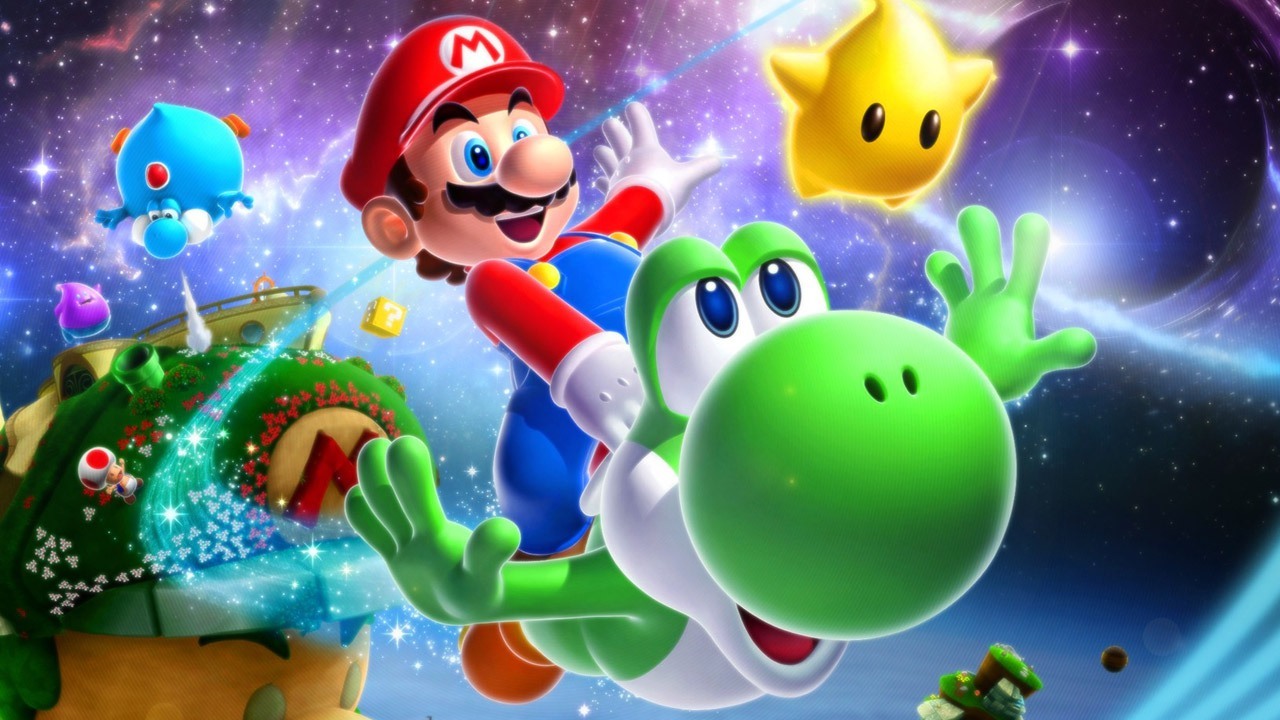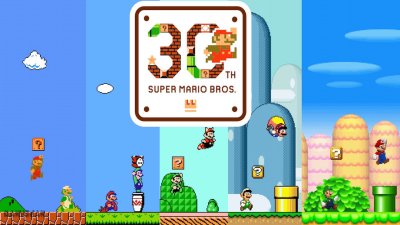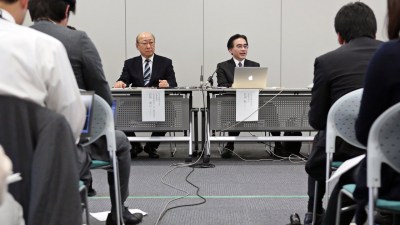Let’s cut to the chase: Super Mario Galaxy 2 is a masterpiece, easily one of the greatest platform games of the last twenty years, and right up there as one of the greatest games of all time. It’s also been recently made available on the Wii U eShop. If you haven’t played it, you need to go and do so now. To pass it over is to ignore one of the most important Nintendo releases of the last decade, but to ignore one the most important games ever released, period.
3D Mario games are usually expected to offer up game-changing innovations. On the surface at least, Galaxy 2 didn’t do this. It’s that rarest of things: a sequel to a core Mario platformer, released on the same system as its predecessor - something not seen since the halcyon days of the NES (Yoshi’s Island, also known as Super Mario World 2, was effectively an entirely new game, so it doesn’t really count). Because of this, anyone who played the first Galaxy game will feel instantly at home - you still waggle to wiimote to make Mario perform a spin attack, you’ll still traverse the surface of small (and not so small) Planetoids before launching yourself into space and moving on to the next; and you’re still on a mission to rescure Princess Peach. In fact, during the early stages of its development, Galaxy 2 was intended to simply be an enhanced version of the first game, with the working title of Super Mario Galaxy More, with a short turnaround period of a year.
Super Mario Galaxy brought major innovations to the platforming genre, and it’s true that in many ways, Super Mario Galaxy 2 offers more of the same. But Miyamoto’s sequel refined what made Super Mario Galaxy great in the first place, poured in a ton more ideas, refined the visuals and audio, and generally chucked in a few more cups of awesome for good measure. Even power ups and ideas directly carried over from the previous game - such as the Bee and Boo suits, are given a whole new lease on life, while the development team - fresh from their work on the first game - took the existing concepts to new and even more inventive heights. The result is that Galaxy 2‘s levels are frequently - and delighfully - subversive, playing and stretching the original concepts in exciting new directions, finding new ways to make use of power-ups like the Bee Suit, and significantly upping the challenge over what was already a deceptively tricky game.
Strangely for a sequel, Galaxy 2 doesn’t actually follow on from the events of the first game, but rather acts as a sort of alternative take on them (sort of - it’s better to just go with it). Bowser kidnaps Peach, because clearly he suffers from Obsessive Compulsive Disorder and if he doesn’t kidnap her ten times a month, he thinks his family will die or something. Mario, as always, gives chase - because he’s got nothing better to do (like, you know, plumbing), and away they go… into space. It’s business as usual, except Mario falls in with a crew of space explorers, and after a brief introduction, he takes over their ship and remodels it to look like his own face because his ego knows no bounds. I wish I could tell you there was much more to it, but it’s a Mario game. The series has never needed to offer a deep and enthralling story, because the sheer joy of Mario games is to be found in the fantastic level designs that Miyamoto and his team throw into every new iteration (yes, even the Gamecube’s Super Mario Sunshine - which is far better than people give it credit for these days).
Sadly, Galaxy 2 replaces the first game’s explorable HUB with a standard overworld map. It’s more streamlined perhaps, enabling players to quickly reach their next destination; but something has definitely been lost in the transition from the charming hubs seen in Super Mario 64 and Super Mario Sunshine.
But this change to a more traditional structure does serve one purpose - it puts the game’s focus squarely on the wondrous levels created by the development team. Every single stage has a unique feel, and every level without fail offers up a brilliant new mechanic that lesser developers would probably use to sustain an entire game. As soon as you’re comfortable with using the Drill power-up to reach new areas in a bizarre gravity defying environment, you’re thrown into a level that has two sets of platforms that will switch every time you spin in the air, leading to some hilariously poorly judged jumps, and inevitable deaths. New ideas are introduced and discarded at such a rate that you have to wonder when the game will start to run out of new ideas; amazingly, it never does - managing to feel just as fresh and unpredictable 30 hours in as it does in the first 5 minutes.
While you’ll see the same power-ups more than a few times on your journey, it’s very unlikely that you’ll be using them in the same way twice. Nintendo constantly forces you to think outside the box, and find new ways to make use of familiar tools. New power-ups are here though - it wouldn’t be a Mario game without a few new toys - and they’re all excellent. One new suit lets you throw out clouds to use as platforms, while another lets you roll around in a giant rock at high speeds, destroying everything in your way.
And then there’s Yoshi. While Yoshi has popped up in a 3D Mario game before - the aforementioned Super Mario Sunshine - his appearance here is inspired. Not only does jumping on your scaly green friend change the way you look at a level, using his tongue as a weapon and grappling hook to reach new areas; he also brings his own unique power-ups to the table, such as a spicy fruit that sends him sprinting across levels at high speeds, and even up walls, in a fun 3D dash that would make Sonic the Hedgehog green with envy.
As good as it is, the first Galaxy game, while awesome, is lacking in challenge - bar a few choice moments. Super Mario Galaxy 2 ups the difficulty significantly, perhaps a sign that Nintendo was confident players would go into it familiar with its concepts after playing the first game. Galaxy 2 isn’t afraid to throw out a devious piece of level design that will have you pulling your hair out as you fail for tenth time. The game’s final third offers up the kind of devilish platforming challenge I haven’t seen in a Mario game since Super Mario World; and that’s before you get to all the post-game levels, which are guaranteed to throwing your wiimote across the room (in a good way, of course). But it’s always fair: never once do you feel as though the game has cheated you. Die, and it’s your own fault - usually as a result of overconfidence, or becoming panicked and making a wrong move in one of the game’s races against evil clone Cosmic Mario. And Galaxy 2 eases you into things gently, ratcheting up the difficulty in such a well-considered way that you won’t even notice to start with. Many developers - particularly in the platformer genre - seem scared these days to offer up a challenge, aiming instead to appeal to a younger audience. Nintendo is confident enough in the robustness of its own design talent that it’s happy to up the ante and keep upping it right through the final stage. Honestly, the final handful of levels are among the most challenging you’ll have ever seen in a game. It’s often - unfairly - claimed that Mario games are designed for kids. Super Mario Galaxy 2 will make those people eat their words.
On the visual front, Galaxy 2 is unmatched by anything on the Wii, and even puts a few PS3 and 360 titles to shame. It might not sport the flashy smoke and particle effects of games residing on the PS3 and Xbox 360, and it also didn’t enjoy true HD resolution. But I’d rather take the vibrant, colorful galaxies of this game than the dull grey mountains of Skyrim any day of the week. Every stage in Mario Galaxy 2 has a different look and feel: from a lush green galaxy, to a deep blue ocean galaxy, to a woodwork galaxy… Yeah, that last one sounds weird, but it still looks awesome. Characters and enemies are all wonderfully rendered animated, and the game possesses some fantastic lighting effects. Despite being designed to run on what is now archaic hardware, it’s a testament to the skill of Nintendo’s visual designers that Galaxy 2 still holds up incredibly well today - which is great, given that it was recently re-released on Wii U’s Virtual Console service.
Complimenting those visuals is an orchestral score that will have you humming its tunes long after you’ve finished the game. Some of Nintendo’s best work can be found here; whether it’s a sweeping orchestral track playing as you soar across a world, or a pared-down remix of classic NES or SNES-era tunes, it’s guaranteed to put a nostalgic smile on your face. Galaxy 2 features some of Nintendo’s finest musical work, thanks to the talents of composers Mahito Yokota, Ryo Nagamatsu, and Koji Kondo.
Yokoto’s work on the Galaxy games saw him returning for subsequent Mario titles - including the Wii U’s excellent Super Mario 3D World. Nagamatsu’s work can be heard in some of the tracks on last year’s Mario Kart 8 and Super Smash Bros. Koji Kondo, meanwhile, is a verteran of the series, his work with Nintendo’s mascot dating back to the iconic Super Mario 64. Every track is a treat for the ears, but has so far unfortunately not seen a release outside of its native Japan.
Even the best games have flaws, however; the need to waggle the wiimote to perform Mario’s spin felt like an unnecessary bolting-on the Wii’s motion controls at the time and even more so now; and, mainly due to the game being a direct continuation of the concepts seen its predecessor, for all its invention and creativity, Galaxy 2 is still a refinement of an earlier game. But such small niggles are easily swept aside by the sheer joy of playing, and Galaxy 2 is an absolute delight to play, as close to perfect as any game has ever achieved. Every fiber of Super Mario Galaxy 2‘s being, from level design, to appearance, to the way it sounds, simply oozes love and charm; a level of attention to detail, creativity and effort that you just won’t find in any other platformer in recent memory.
Mario Galaxy 2 is a testament to the care Nintendo put into their products, and it shines through in every moment of your journey to grab all 242 Stars. If you haven’t played this game, I implore you: check it out today. You won’t regret it.








